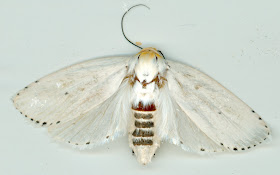Cryptophasa delocentra (Meyrick, 1890)
♀ - NSW, 23 km NNE of Coonabarabran Lat. 30' 06" S Long. 149' 24'' E, 7. Dec. 1974, I.F.B. Common E.D. Edwards leg. (ANIC). Photo Len Willan.
♂ - NSW, 9 km W of Coonabarabran Lat. 31' 17" S Long. 147' 11" E, 8. Dec. 1974, I.F.B. Common E.D. Edwards leg. (ANIC). Photo Len Willan.
♂ - NSW, Pilliga State Forest, 21. Nov. 1981, V.J. Robinson R. Badans leg. (ANIC). Photo Len Willan.
♀ - gvc5004, Herveys Range, Queensland. Collected by Graeme Cocks.
♀ - gvc5004, Herveys Range, Queensland. Collected by Graeme Cocks.
♂ - gvc6235, Herveys Range, Queensland. Collected by Graeme Cocks. Collection of the Australian Museum.
Cryptophaga delocentra Meyrick, 1890. Descriptions of Australian Lepidoptera. Part I. Xyloryctidae. Transactions of the Royal Society of South Australia 13: 23–81 (39). Holotype BMNH ♀, Sydney, NSW.
Cryptophaga delocentra Meyrick, 1890. Lower, 1892: Descriptions of New South Australian Lepidoptera. Transactions of the Royal Society of South Australia 15: 5-17 (16).
Cryptophaga delocentra Meyr. Turner, 1898, The Xyloryctidae of Queensland. Annals of the Queensland Museum 4: 1–32 (9).
Cryptophaga delocentra Meyr. Lower, 1917, The Lepidoptera of Broken Hill, New South Wales. Part III. Transactions of the Royal Society of South Australia, 41, 369-477 [369].
Cryptophasa delocentra (Meyrick, 1890). Common, in Nielsen, Edwards, & Rangsi, 1996, Checklist of the Lepidoptera of Australia. Monographs on Australian Lepidoptera, 4: i-xiv, 1-529 & CD-ROM (86).
Cryptophasa delocentra (Meyrick, 1890). Beccaloni, G. W., Scoble, M. J., Robinson, G. S. & Pitkin, B. (Editors). 2003. The Global Lepidoptera Names Index (LepIndex). World Wide Web electronic publication. http://www.nhm.ac.uk/entomology/lepindex [accessed 15 April 2010].
Cryptophasa delocentra (Meyrick, 1890). Edwards, E. D. (2003), Xyloryctinae. Australian Faunal Directory. Australian Biological Resources Study, Canberra. http://www.environment.gov.au/biodiversity/abrs/online-resources/fauna/afd/taxa/XYLORYCTINAE [accessed 18 June 2010].
Original description, Meyrick 1890
Crypt. delocentra, n. sp.
Female 40mm. Head whitish-ochreous. Palpi white, terminal joint ¼ of second. Antennae black. Thorax white, anteriorly ochreous-tinged. Abdomen blackish, sides and segmental margins white, basal segment white, second segment orange-red. Legs black, ringed with white. Forewings oblong, posteriorly slightly dilated, costa gently arched, apex obtuse, hindmargin rather obliquely rounded; 2 from ¾; shining snow-white; a large black dot in disc beyond 1/3; and two others transversely placed in disc at 3/5, lower rather posterior; a row of small black spots along hind margin and apical fourth of costa: cilia white. Hindwings with veins 6 and 7 from a point; snow-white; a hindmarginal row of small black spots; cilia white, basal half indistinctly barred with dark fuscous on hind marginal spots.
Sydney, New South Wales; one specimen bred in December. Larva residing in a barricaded tunnel in young branches of Ceratopetalum gummiferum, carrying in leaves for food, in October.
Subsequent description, Lower, 1892
Crypt. delocentra, Meyrick.
Male, 26-30 mm. Differs from female in having extreme costal edge blackish; the hindwings are distinctly black with snow-white cilia. In some female specimens the hind wings are strongly suffused with blackish, and some specimens measure 54 mm. in expanse.
Thirty-two fine specimens, male and female, at a street lamp at Parkside in December. I have also seen specimens from Queensland and Sydney, so that it would appear to have a wide range.
Other references
[Cryptophasa nigricincta] Closely allied to C. delocentra, Meyr., and subsequent research may show that it is merely a geographical form of this species. The male, however, appears very distinct, and the female may be distinguished by the black second abdominal segment. A considerable series shows these differences to be constant. We have seen both sexes of C. delocentra taken by Mr. Lower in South Australia, and in these the forewings of the male are white. (Trans. Roy. Soc. S.A. 1892.) (Turner, 1898).
Cryptophaga delocentra, Meyr.
Nine specimens, both sexes, from October to November. Bred from Eucalyptus rostrata [E. camaldulensis].
Diagnosis: Sexually dimorphic moths; females white with black markings, males much smaller, grey with black markings and dark grey hindwings; head yellow. Palpi short, terminal joint ¼ of second. Male genitalia distinguished by flared, pointed supravalva, short claspers, relatively small basis valvae.
Description:
Head:
Cryptophasa delocentra ♀ head, gvc5004, Herveys Range, Queensland. Collected by Graeme Cocks.
Thorax:
Abdomen:
Cryptophasa delocentra ♂ adominal pelt, gvc6235, Herveys Range, Queensland. Collected by Graeme Cocks. Dissection Ian McMillan. Slide in collection of the Australian Museum.
Cryptophasa delocentra ♂ genitalia, gvc6235, Herveys Range, Queensland. Collected by Graeme Cocks. Dissection Ian McMillan. Slide in collection of the Australian Museum.
Cryptophasa delocentra ♂ aedeagus, gvc6235, Herveys Range, Queensland. Collected by Graeme Cocks. Dissection Ian McMillan. Slide in collection of the Australian Museum.
Food plants: Larva boring in stem and tying cut leaves to bore entrance. Larval foodplants: Ceratopetalum gummiferum (Cunoniaceae); Eucalyptus gummifera, E. camaldulensis (Myrtaceae). (Edwards, 2003).
Flight period: October, November, December, February.
Distribution: New South Wales, Queensland. Endemic. (Edwards, 2003).
Remarks: This species and C. nigricincta may or may not, as Turner opined, be conspecific. It also seems there may be more than two species within this complex: the division into delocentra (with red abdominal band) and nigricincta (with black abdominal band) may be an arbitrary one, based on convenience.
The geographical division based on the distribution of nigricincta in Queensland, delocentra in the southern states, does not seem to be entirely borne out by the available specimens.
The specimens identified as delocentra that I have dissected and illustrated here had red abdominal bands, and came from Queensland. That is not to say that they are necessarily identical with southern delocentra-type specimens.
See also Cryptophasa nigricincta.
+Coonabarabran+NSW++F.jpg)
+Coonabarabran+NSW++M.jpg)
+Pilliga+SF+M.jpg)





.jpg)
